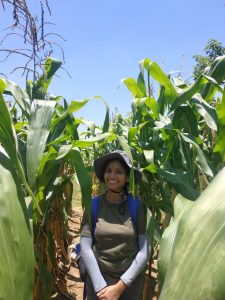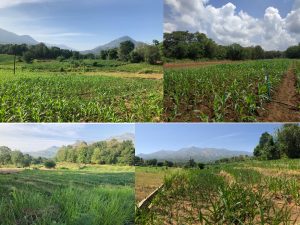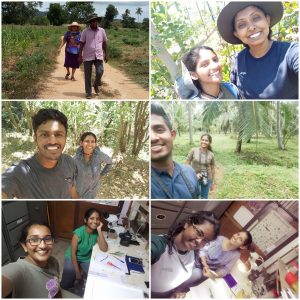After 2 episodes of research cradle articles, we think our audience is a bit familiar with the concept of the undergraduate research projects done by our own alumni students. It is with great pleasure, we at FOS Media Blog, introduce you to these amazing personalities and their valuable projects through this Research Cradle article series. So with no more lengthy introductions, this time we introduce you to the speaker of today’s episode, Ms. Ramalka Heshani Kasige, and her research on Fall Armyworm.

Ms. Ramalka was a Zoology (Hons) student from the Department of Zoology and Environmental sciences. She was born on the 8th of April, 1994 as an only child. Now she is a 27 years old graduate student with a first-class degree, currently working as an assistant lecturer at the Department of Zoology and Environment Sciences of the Faculty of Science, University of Colombo itself. Ms. Ramalka went to Bishop’s College, Colombo 03, till her selection to the Biological Science program offered by the Science Faculty of the University of Colombo.
This talented and enthusiastic personality has not been a stranger among many extra-curricular activities done within the university as well as in the outside community. Ms, Ramalka has been a hard-working student since school times. She has been the President of Sinhala Literary Association of Bishop’s College and the Secretary of Science Society, the Captain of the school Sinhala debating team, and the Chief Editor (Sinhala) of Annual School Magazine in the year 2012. She was also a Chorister in the school Western choir from 2006 to 2009 and the Eastern choir from 2004 to 2012.
Ms. Ramalka made the university a great opportunity to achieve an excellent academic career. She has received many awards and gold medals for her academic work including the Justin Samarasekera Award (2020) for the most outstanding Science student of the year, graduated from the Faculty of Science, the University of Colombo with First-class honors & made a considerable contribution to the student community while studying at the university and the Gulamhusein A. J. Noorbai Gold Medal for the Best Student Specializing in Zoology (2020).
Meanwhile, she developed her other talents and many soft skills as well. She has been a blogger, a reporter, and an announcer at the FOS Media, the official media unit of the Faculty of Science, the University of Colombo since 2016. She acted as a senior editor in 2017 and as the editor-in-chief during 2018, for the FOS Blog.
Ms. Ramalka was not only a media person but also a great public speaker. She has been a member of the Gavel club since 2016 and was the editor for the Gavel Club of the University of Colombo (2017/2018). In addition, she was a member of the Leo club of UOC, FOS from 2016 to 2018, a member of BEEZ since 2016, and contributed to the club as the Editor for the administrative year 2018/2019 and a member of Euphony Choir since 2018.

However, her talents were not restricted to the aforementioned roles. She was an orator, a debater, and a compere in many Inter-University events and competitions. She is also the proud winner of the Oration 2020, Intra-University Speech Competition organized by Gavel UOC. Amidst all this work, Ms. Ramalka was able to conduct a very successful research project as her 4th-year undergraduate research component during 2019. Her project title was namely, “Life history characterization, cannibalism rate and possible bio-control of Fall Armyworm, Spodoptera frugiperda (‘Sena’ caterpillar; Lepidoptera, Noctuidae) in Sri Lanka.
This said research project was a study on Fall Armyworm, Spodoptera frugiperda (‘Sena’ caterpillar); a voracious pest species that invaded Sri Lanka’s crops, especially Maize in mid-October 2018. She researched under the supervision of Prof Chandima Dangalle and Prof Nirmalee Pallewatta; professors of the Department of Zoology and Environment Sciences.

Surprisingly when it was time to select a topic for the research, at first, Ms. Ramalka did not have any clue on what sort of a research project that she would be doing. However, she had a clear idea that no matter what it is, it should be entomology-related research as her interests are in insects (specifically butterflies and dragonflies). Thus, when the country’s agrarian sector was facing a huge loss due to the Fall Armyworm attack at that time, she felt that she should work on this problematic pest species to contribute to the lacking knowledge in our country about this pest species. So, the researcher secured the topic of the project. Ms. Ramalka started her project in January 2019 and continued until December 2019 for nearly one year.
This particular research had both laboratory and field components. Ms. Rmalka collected Fall Armyworm larval stages and eggs by field sampling. Sampling was done in 10 sites of four main locations in North – Central, North-Western, and Uva Provinces of Sri Lanka. The species was reared in the insectary facilities at the University of Colombo and 6 generations of Fall Armyworm were observed during the study period. Morphological and morphometric analysis, Cannibalism experiment along cafeteria experiments using Arboreal Tiger Beetles were conducted in the laboratory setup. Arboreal Tiger Beetles needed for the study were collected from an agro-ecosystem in Dambadeniya.

With her research project, Ms. Ramalka was able to deduce few important findings. They are;
- Fall Armyworm infestation varied in different climatic zones of Sri Lanka in different harvesting seasons. The larval stage is the most abundant life cycle stage in fields.
- Morphological and morphometric study on the life cycle stages provided a sufficient guide for identification and various characters can be used for sex separation of the adult moth.
- Larval cannibalism among conspecifics displayed in different proportions with the highest proportion among 5th instars. No cannibalism in the 1st and 2nd instar stages.
Currently, Ms. Ramalka is working on her publications. The field trials should be conducted on a few aspects of this topic as laboratory studies have already been covered from her undergrad study.
Regarding the publications, two publications are to be released, namely;
- Kasige, R. H., Pallewatta, N., Dangalle, C. D., & Perera, M.T.M.D.R. (2020). Larval cannibalism among conspecifics of Fall Armyworm, Spodoptera frugiperda (Lepidoptera, Noctuidae) in Sri Lanka [Abstract]. Proceedings of the 40th Annual Sessions of the Institute of Biology 2020, pp 21.
- Kasige, R. H., Pallewatta, N., & Dangalle, C. D. (2021). Morphology and morphometrics of egg masses of Fall Armyworm, Spodoptera frugiperda (Lepidoptera, Noctuidae) in Sri Lanka [Abstract]. Proceedings of 25th International Forestry and Environment Symposium of the University of Sri Jayewardenepura, pp 41.
When we asked Ms. Ramalka about any special people that she wanted to acknowledge, she quoted, “I am extremely grateful to Prof Chandima Dangalle and Prof Nirmalee Pallewatta; professors of the Department of Zoology and Environment Sciences, the University of Colombo for their guidance and encouragement gave throughout the research project”. She also offered her profound gratitude to her parents for supporting her throughout by helping with field and laboratory work and for being a strength at all times.
In addition, she mentioned all the agricultural officers who supported her with fieldwork. She didn’t forget to remind the assistance she received from Miss. Nisansala Perera, Mr. Thejana Paranagama, Mr. Tharindu Dilshan, Miss. Bhagya Amarasinghe and Miss. Sadani Panchasika in conducting field and laboratory work which was highly appreciated by her. She was also thankful to Mr. Tharaka Wijerathna, Mr. Tharindu Ranasinghe, and Mr. Nuwan Chathuranga for the support given in insect identification.

When considering an undergraduate project, it is never easy to conduct research that requires a lot of fieldwork. Yet Ms. Ramalka did an amazing job and was able to produce a very successful project. We congratulate her for her hard work and wish her all the best with her future endeavors and higher studies. Ms. Ramalka has always been a very valuable asset for us at FOS Media, and we are proud of her. Thus we think it would be fair to add a personal good luck wish from the FOS Blog team as well. We wish you success in your future, Ms. Ramalka. See you with another episode of Research Cradle soon. Stay tuned.

